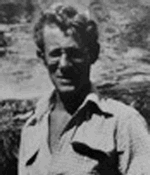
Chalmers Clapperton at Nisqually Glacier, Cascade Range, 1981.
Chalmers Clapperton, Professor of Geography at the University of Aberdeen, died on 23rd October, 2018. Chalmers was a researcher and university teacher lauded internationally for his insights into Quaternary glacier fluctuations and their relationship to past environmental and climate changes. He cut his teeth on a PhD supervised by Brian Sissons at the University of Edinburgh in 1967 entitled The Deglaciation of the East Cheviot Hills. His research on the Ice Age continued within Scotland but extended to include studies of glacier changes in Iceland, Svalbard, the Falkland Islands, the Antarctic Peninsula and the sub-Antarctic islands of South Georgia and South Shetland Islands. Further outstanding contributions came from his work in South America where he looked at how high-elevation glaciers in Peru, Bolivia and Ecuador changed in extent as they responded to climate change and volcanic eruptions, a topic of keen interest to surrounding populations dependent on the glaciers for water. Chalmers’ later work was in Patagonia where his findings revealed how glacier histories at different latitudes could be linked to latitudinal migration of the Southern Westerlies.
Chalmers Clapperton was renowned for his sheer skill as a fieldworker who made new discoveries, and also for his ability to place them in their wider context. This is borne out in the large number of his publications which presented the first geomorphological maps of new areas, whether they are in Scotland, Iceland, Svalbard, South Georgia, the Antarctic Peninsula or in many locations in South America. Invariably, the maps are detailed, perceptive, integrated with sedimentary evidence and have proved to be the building blocks for further research. A second major feature of Chalmers’ work was his ability to synthesise and link glacier changes to wider environmental changes in vegetation and climate. He brought an adventurous mind to bear on a wealth of empirical knowledge and developed it into far-reaching hypotheses. There are several significant review papers but the jewel in the crown is the magisterial Quaternary Geology and Geomorphology of South America, published in 1993. This involved bringing together ideas and the literature in Portuguese, Spanish and English for the whole continent in a substantial blue-bound volume. It still remains the first port of call for a new Quaternary researcher in South America, where the volume is affectionately known as The Blue Bible.
Another outstanding quality was Chalmers’ inspirational teaching ability, which drew generations of students to the study of the Quaternary. He loved to teach in the field and was renowned for his cheerful optimism whilst enthusing students in inclement weather in Iceland or the Scottish Mountains.
I worked with Chalmers on geographical research in Scotland, Antarctica and Patagonia and have many personal memories that will chime with any of his former students reading this journal. I remember Chalmers for: his breath-taking speed walking up any hill; his enthusiastic singing in the back of an Alexanders’ bus returning to Aberdeen from the Cairngorm Mountains; being dragged out for an early morning run whilst at scientific conferences. Working with Chalmers in Antarctica, I remember him: playing wistful Scottish tunes on a mouth organ, sometimes to an audience of intrigued penguins; skiing behind a skidoo on the flat surface of George VI Ice Shelf in hot sunshine; being the first person to land on a newly erupted volcano at Deception Island, later named after him; disappointment when the sea washed the island away; being humbly surprised that a ridge in the Pensacola Mountains has been named after him. And in Patagonia my memories are: slipping in from our small tents to have breakfast in a posh hotel overlooking the magnificent view of the cliffs of Torres del Paine; my gratitude that he spoke Spanish, a skill that got us out of several bureaucratic scrapes; the wrong choice of an open pick-up truck to support our work since, for security, we had to store all the equipment in the small cab; and finally, evening dinners of local food supplemented by Chilean red wine to celebrate and discuss another good day’s fieldwork with research students.
In 1951–1957 Chalmers was a top scholar at Hawick High School and he captained the Scottish Schools rugby team. His undergraduate years in the Department of Geography, University of Edinburgh, saw him win prizes in every year in both geology and geography and culminated in a First Class Degree in 1961. Moving to the Department of Geography in Aberdeen in 1962, Chalmers was promoted to Professor in 1992. He was elected a Fellow of the Royal Society of Edinburgh in 1992 and was awarded the Royal Scottish Geographical Society’s President’s award in 1992, the Mungo Park Medal in 1997 and the Centenary Medal in 1999. In September 1998, he was cut down by a stroke at the very height of his powers. This tragic loss was marked by a tribute volume of the Journal of Quaternary Science in 2000 entitled: Quaternary climate change and South America, put together by international colleagues.
Chalmers married Morag who was a rock of support since school days and had to cope with being a fieldwork widow on so many occasions, along with their two children, James and Andrew. During one summer after the stroke, Chalmers, with Morag’s support, was able to visit Patagonia and reconnect with his friends in South America – a moving experience.
